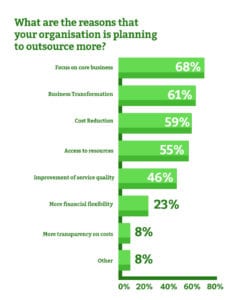
Currently doing the rounds are rumours that 2016 could see a significant drop in demand for outsourcing services in the UK. Instinctively, when you see headlines like this, it’s reasonable to apply a degree of scepticism to such talk, but we should remember that there’s rarely smoke without fire.
So where are these rumours coming from, and how dramatic a shift in preferences are we likely to see? First, it’s important to remind ourselves why we outsource in the first place. Second, we need to understand what steps we can take to ensure that we cultivate a more effective outsourcing approach.
So, why do we outsource?

The reasons vary and are dependent upon an organisation’s objectives, but an overview can be gained from a recent study conducted by PA Consulting and Whitelane Research, in which 68% of respondents cited ‘focusing on core business’ as a primary reason for outsourcing. ‘Business Transformation’ was the reasoning for 61%, and while ‘cost reduction’ isn’t cited as being as important as it once was (although it’s not clear whether the sample included public sector organisations), it was still noted as a reason for outsourcing by 59% of those asked. After these came ‘access to resources’ at 55% and ‘improvement of service quality’ at 46%.
So for organisations to move their focus away from outsourcing, instinct tells us to consider that this could be because their existing or previous outsourced services are not achieving their expectations in some of the above areas.
While some outsourcing critics might say that their service user goals are achievable via other (in-house) means, there still appears to be a healthy appetite for outsourcing in the UK market.
From this same study, 40% of respondents said that they would like to outsource more, compared to 29% who are content with their existing levels of outsourcing, and just 15% who intend to outsource less. These statistics suggest that many UK organisations still see outsourcing as a means to ‘focus on core business’, to achieve ‘business transformation’, and ‘cost reduction’ while gaining ‘access to resources’ and an ‘improvement of service quality’.
So why then are some people citing 2016 as the death knell for outsourcing as we know it? In the face of statistics like these, it’s difficult to take the view that outsourcing is about to shuffle off this mortal coil. Skimming through the headlines of the past three months, however, it becomes a little easier to see why. The IT and outsourcing headlines are rife with insourcing stories and tales of outsourcing termination.
It’s important though that we do our best to examine why these organisations are insourcing and terminating their contracts. Could it be that outsourcing today is inherently flawed? Or is it deeper than that?
Who’s moving from outsourcing to insourcing?
Bournemouth Council

One well-known, recent example, is that of Bournemouth Council. They recently made the decision to bring IT and other services back in-house to gain more control over their budget. After the government had cut its grant by £14m, they were suddenly faced with tough cost-cutting targets. Of increasing concern, council leader John Beesley said the authority needs to find savings of a further £12m in the 2016/17 financial year.
He was also noted as saying that:
“In this increasingly difficult financial environment, the council needs to control directly the £14m associated with the [outsourcing] contract.”
So while cost is a concern here, the council’s priority seems to be with the control of those costs, where changes can be made ‘at will’, rather than having to take the time to renegotiate their service provision with an outsourcing provider.
It’s also worth noting that there seemed to be little indication that ‘quality of service’ and value for money were cited as considerations in this decision.
The decision to in-source, if approved, will see more than 200 staff being transferred back to the Dorset authority from supplier Kier. It was also noted that in December, Dorset Council rejected outsourcing as an option for its back-office services, including IT, because it would not provide the flexibility it required.
DVLA
In another story, the DVLA also took the decision to in-source its IT services. The move, completed last year in September, saw more than 300 staff moving from suppliers to the DVLA. The move is forecast to save some £225m over ten years. On the face of it, it seems that cost is once again the main driver, but according to DVLA CEO Oliver Morley:
“If you are going to transform an organisation digitally you have to own the IT… You need to be your own systems integrator or you do not have the ability to change.”
Upon further investigation, Morley found that their previous outsourcing contracts were a poor fit for the organisation’s ‘digital future’. It was felt that they did not allow for fast changes in response to business demand. From their previous experience, they knew that it would take weeks to get the contract right to allow for even small changes.
Astra Zeneca
In the private sector, further down the line with their IT insourcing project, Astra Zeneca are already beginning to see some significant benefits. After taking the insourcing decision in 2013, they’ve replaced seven major suppliers and saved £243m a year in the process. A stark change for an organisation that used to outsource 70% of its IT. It was felt that they weren’t getting value for money. Vice-president of IT strategy and performance, Chris Day said that:
“We were really underperforming as an IT organisation… We were very slow, very inflexible, had terrible issues with quality, as well as a high level of dissatisfaction with IT in the business. We had to regain control of IT to fix this…”
When asked about the root of the problem, Day pointed to a huge supplier management overhead where coordinating projects was taking more effort and resources than it would to deliver them directly.
“We had become good at supplier management, but lost the individuals who really understood technology, could make informed choices and get quality work done quickly,” he said.
What’s interesting about these examples is that flexibility and control seem to have been the crux of the decision to in-source. The cost savings seem to be more of a consequence, rather than being a critical factor. These examples don’t exist in isolation, however. According to the PA Consulting report, while many respondents seem keen to outsource, there’s evidence to suggest that existing service delivery needs to improve if this is to continue.
The study reports that 44% of respondents were unsatisfied with their existing outsourcing arrangements. Looking at the reasons why, the survey demonstrates poor scores on innovation, proactivity and ability to drive change. As businesses begin to focus on business transformation, as the DVLA are, it seems that organisations are starting to think more widely about their organisational goals and the importance of innovation in IT before making the move to outsource.
What can outsourcing providers learn from this?

While the accounts mentioned above are few and anecdotal compared to the overall scale of the market, they do go some way to show that flexibility and control have been critical to service users and as time goes on, our experience is that such flexibility is becoming increasingly important. What is interesting is that while many organisations see outsourcing as a means to work towards ‘business transformation’, some of those that have already been there don’t feel that there’s enough flexibility in this strategy to truly achieve this goal.
Similarly, in these times of ‘extreme austerity’, some are finding that direct control of service delivery can be translated into cost savings quite quickly as changes can be made ‘at will’ without incurring contractual or legal costs.
But when 59% of people look at outsourcing as a means to reduce costs and 61% see it as a route to business transformation, given recent evidence of such objectives not being achieved, one does have to wonder whether it’s the outsourcing partners that need to alter their approach, the service users themselves, or whether both parties need to collaborate differently in forming and operating future strategic partnerships.
Historically, outsourcing contracts have always been difficult to renegotiate without substantial cost to the client (service user) and it’s not uncommon for this process to take quite some time. When you take into account the additional resources needed to manage such a relationship from the client-side, you can see how, when taken together, these outsourcing nuances can manifest as a rigid, costly and slow to adapt process – exactly what these insourcers are trying to avoid in pursuit of innovative business transformation.
6 steps for a more effective outsourcing approach
1. Achieve clarity of the business outcome

One of the most common problems we find in outsourcing relationships pertains to outcome clarity. If you’re unclear about the specific outcomes you would like your partnership to achieve, your supplier will do their best to translate them. This could lead to outcomes that don’t quite match your expectations. At the same time, vague outcomes are notoriously difficult to judge, benchmark and measure. To get the greatest value from your outsourcing provider, you need to have a clear understanding of what ‘tomorrow looks like’. Imagine your project is implemented and it’s all plain sailing – what can you do now that you couldn’t before? How has that translated into value for your organisation? This thought exercise can sometimes reveal that different stakeholders have differing expectations of the project’s envisioned deliverables. Refine and align this imagined future and do your utmost to quantify the value it brings. This will leave little room for things to get lost in translation.
2. Evidence that your organisation can transform

In some outsourcing partnerships, we find that a client has attempted to outsource a ‘problem’. Before you outsource a problem, consider whether or not you have the ability to adapt internally. If you can’t, think carefully about how outsourcing it will change that. Very often, changes in organisational attitudes, perceptions and behaviour are needed to allow ‘business transformation’ to take place. Be mindful that to facilitate such change, you’ll likely need to implement internal mechanisms to ensure that the provider’s recommendations are truly adopted.
3. Evidence that your provider can transform

Organisations that truly believe in something will often implement it themselves internally. This is particularly true of ‘transformational change’. Many profess to understand it, but few can evidence this. Those providers that can evidence effective transformation within their organisation are far more likely to achieve effective change for their clients.
4. Build in regular service and contract ‘reshaping’

If you don’t contract for ‘innovation’ and you don’t put strong (read: executive-led) governance in charge of the innovation, then it’s unlikely that you’ll achieve it. In turn, your contract needs to allow for a six-monthly ‘reshaping’ cycle as a minimum and which takes into account changing outcomes and objectives. Providers that can’t deal with ‘changing service delivery’ as a result of changing business outcomes (i.e. protecting margins at the expense of innovating service delivery) will reveal whether or not your relationship will be flexible enough to achieve the outcomes you desire.
5. Ensure there is commercial sustainability

The best contractual structure in the world will not drive ‘enabling behaviours’ if the commercial model between you and your provider is unsustainable. Having a clear baseline on existing service delivery cost structures and service levels, along with appropriate commercial due diligence on your provider, means you can make an informed decision before you outsource. So you can determine whether you are likely to (a) achieve the efficiencies, cost savings and service level improvements, and (b) if you are insourcing, whether the evidence from these same questions is likely to lead to a more effective outcome.
6. Strengthen your management governance

Keeping the momentum, with ‘enabling’ behaviours from both your organisation and the provider organisation is key to driving a value-adding outcome that continuously aligns to the changing circumstances both the provider and the service user will find themselves in. One of the best ways to facilitate this is to have an Intelligent Client Function (ICF) team in place to manage and monitor the relationship – maintaining stakeholder alignment while setting realistic expectations. You can find out more about building an ICF team here.
In summary, for some organisations, outsourcing isn’t enough. As the needs of organisations change, there’s a real desire to own a model of service delivery that can accommodate these changes quickly, without the worry of contractual cost implications and the need for excessive resources to manage these changes. They need someone who can provide a more flexible and effective outsourcing arrangement.
Today, digital transformation is at the forefront of professional services thinking so this ‘trend’ looks set to continue. In dealing with hundreds of these partnerships, we find the most effective approach is for outsourcing partners to build relationships that are more collaborative, flexible and easier to mould without the traditional costs and time-sinks incurred when making changes.

